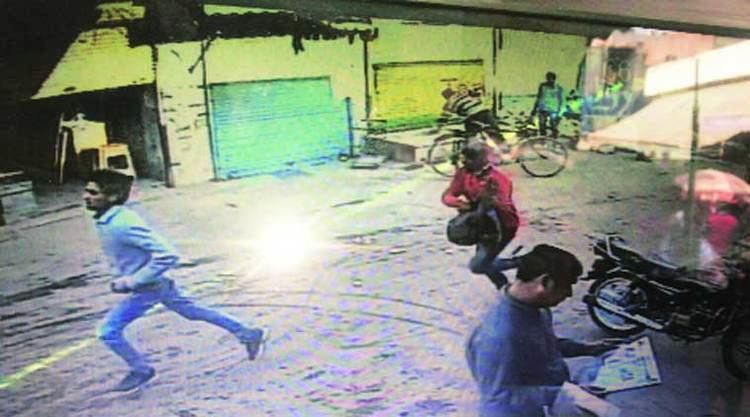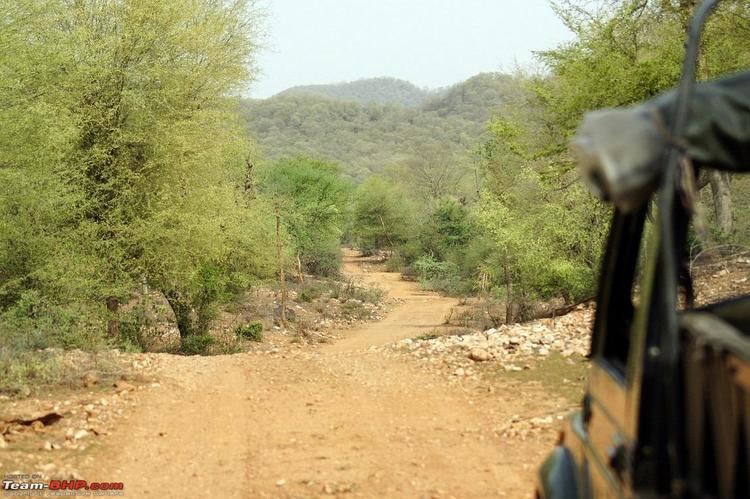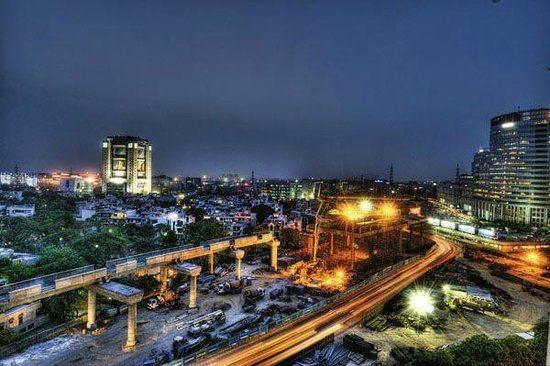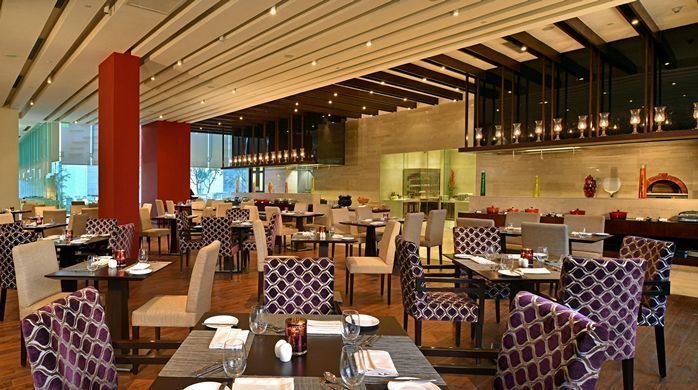Country India State Haryana Mayor Vimal Yadav | Area 282.7 sq mi District Gurgaon district Population 876,824 (2011) | |
 | ||
Colleges and Universities ITM University - Gurgaon - Haryana, Management Development Institute, University of Petroleum and Energy Studies, IILM Institute for Higher Education, Ansal Institute of Technology | ||
Map of Gurgaon
Gurgaon (officially known as Gurugram) is a city in the Indian state of Haryana and is part of the National Capital Region of India. It is 32 kilometres (20 mi) southwest of New Delhi and 268 km (167 mi) south of Chandigarh, the state capital. As of 2011, Gurugram had a population of 876,824. Witnessing rapid urbanisation, Gurugram has become a leading financial and industrial hub with the third-highest per capita income in India. The city's economic growth story started when the leading Indian automobile manufacturer Maruti Suzuki India Limited established a manufacturing plant in Gurugram in the 1970s. Today, Gurugram has local offices for more than 250 Fortune 500 companies.
Contents
- Map of Gurgaon
- Top 10 places to visit in gurgaon
- Dlf privana gurgaon sec76 77 is the best place for resident purpose
- Etymology
- History
- Geography
- Topography
- Climate
- Demographics
- Architecture
- Neighbourhoods
- Parks
- Entertainment and performing arts
- Languages and dialect
- Religion
- Sports
- Economy
- Law and government
- Crime
- Education
- Roadways
- Intercity rail
- Delhi Metro
- Rapid Metro
- Airport
- Public transit
- Utilities
- Flooding
- Fun time in fun and foodgurgaon
- Fun nd food village gurgaon
- Enjoy in fun and food village
- References

Top 10 places to visit in gurgaon
Dlf privana gurgaon sec76 77 is the best place for resident purpose
Etymology

The land came to be known as Gurugram (Sanskrit: गुरुग्राम, lit. village of the Guru) which over time became changed to Gurgaon (गुड़गाँव). The village still exists within the modern-day city.

On 12 April 2016, Chief Minister of Haryana Manohar Lal Khattar announced a retrograde proposal to officially rename the city Gurugram, subject to the approval of the Haryana cabinet and the Union Government. He argued that the new name would help to preserve the "rich heritage" of the city by emphasising its history and association with Dronacharya. On 27 September 2016, Manohar Lal Khattar officially announced that the Union Government had approved the name change, and thus the city and district would henceforth be known as Gurugram.
History
Gurgaon was historically inhabited by the Hindu people, and in early times it formed a part of an extensive kingdom ruled over by Rajputs of Yaduvansi or Yadav clan. The Yadav were defeated by Muhammad of Ghor in 1196, but for two centuries they sturdily resisted the Muhammadian domination and they were subjected to punitive expedition. Under the rule of Feroz Shah Tughlaq, several were converted to Islam. This was followed by the invasion of Timur and the land was ruled by Khanzadas. It was then annexed by Babur. During Akbar's reign, Gurugram fell within the governing regions of Delhi and Agra. As the Mughal Empire started to decline, the place was torn between contending powers. By 1803 most of it came under the British rule through the treaty of Surji Arjungaon with Sindhia. The town was first occupied by the cavalry unit posted to watch the army of Begum Samru of Sirdhana. It became a part of the district, which was divided into units called parganas. These units were given to petty chiefs for the military service rendered by them. Eventually these units came under direct control of the British, with the last major administrative change in 1836. After the Revolt of 1857, it was transferred from the North-Western Provinces to Punjab Province. In 1861, the district, of which Gurugram was a part of, was rearranged into five tehsils: Gurgaon, Ferozepur Jhirka, Nuh, Palwal and Rewari and the modern-day city came under the control of Gurgaon tehsil. In 1947, Gurgaon became a part of independent India and fell under the Indian state of Punjab. In 1966, the city came under the administration of Haryana with the creation of the new state.
Geography
Gurugram is located in Gurgaon district in the Indian state of Haryana and is situated in the southeastern part of the state, and northern part of the country. The city is located on the border with Delhi with New Delhi to its northeast. The city has a total area of 738.8 square kilometres (285.3 sq mi)
Topography
The average land elevation is 217 metres (712 ft) above sea level.
Climate
Under the Köppen climate classification, Gurugram experiences a monsoon-influenced humid subtropical climate (Cwa). The city experiences four distinct seasons - spring (February - March), summer (April - August), fall/autumn (September - October) and winter (November - January), along with the monsoon season setting in towards the latter half of the summer. Summers, from early April to mid-October, are typically hot and humid, with an average daily June high temperature of 40 °C (104 °F). The season experiences heat indices easily breaking 43 °C (109 °F). Winters are cold and foggy with few sunny days, and with a December daytime average of 3 °C (37 °F). The Western Disturbance brings some rain in winters that further adds to the chill. Spring and autumn are mild and pleasant seasons with low humidity. The monsoon season usually starts in the first week of July and continues till August. Thunderstorms are not uncommon during the Monsoon. The average annual rainfall is approximately 714 millimetres (28.1 in).
Demographics
Gurugram municipal corporation area has an estimated population of 876,824 as per 2011 India census.
Architecture
Gurugram has architecturally noteworthy buildings in a wide range of styles and from distinct time period. Gurugram's skyline with its many skyscrapers is nationally recognised, and the city has been home to several tall buildings with modern planning. Gurugram has an estimated 1,100 residential highrises. The average cost of a 93-square-metre (1,000 sq ft) two-bedroom apartment at a decent condominium in Gurugram is at least $160,130 (₹10,000,000).
Neighbourhoods
Gurugram is divided into 36 wards, with each ward further divided into blocks. The housing type in the city consists largely of attached housing, though a large number of attached multi-dwelling units, including apartments, condominiums and high rise residential towers are getting popular. The top five condominiums in the city, as rated by The Times of India, are: Aralias, Hamilton Court, The World Spa, Gurugram One and Raheja Atlantis.
Parks
Gurugram has a complex park system, with various lands operated by the Haryana Urban Development Authority. The key parks are Leisure Valley Park in Sector 29, which is spread over 15 hectares (36 acres); Tau Devi Lal Biodiversity Botanical Garden in Sector 52; Netaji Subhash Chandra Bose Park in Sector 14, popularly known as HUDA Garden; Tau Devi Lal park in Sector 23; and Aravali Biodiversity Park on MG Road. However, most of the parks in Gurugram are small and ill-maintained.
Entertainment and performing arts
Notable performing art venues in the city include Epicentre in Sector 44 and Nautanki Mehal at the Kingdom of Dreams near IFFCO Chowk. Bollywood actor Rajkummar Rao was born in Gurugram.
Languages and dialect
The main language spoken in Gurugram is Hindi, though a segment of the population understands and speaks the English. The dialect used in Hindi is similar to that of Delhi, and is considered neutral, though the regional influences from the states of Haryana, Uttar Pradesh and Punjab adds an accent to the language. English is spoken with an Indian accent, with a primarily North Indian influence. Since Gurugram has a large number of international call centres, the employees are usually given formal training in neutral pronunciation in order to be understandable to native English speakers. Haryanvi and Punjabi are other popular languages spoken in the city. The other regional languages include Mewati and Haryanvi.
Religion
Hinduism is a predominant religion among the city's population. Gurugram also includes adherents of Sikhism, Islam, Buddhism, Jainism, Christianity and the Bahá'í, among others. There are several places of worship for major religions in Gurugram, including mandirs, gurdwaras, mosques and churches.
Sheetla Mata Mandir is a famous temple located in district Gurugram of Haryana state of India. It is a temple dedicated to the wife of Guru Dronacharya. The temple hosts fairs regularly and huge number of people come to seek blessings of Sheetla Mata every year.
Sports
The city has two major sports stadiums: Tau Devi Lal Stadium in Sector 38, which has facilities for cricket, football, basketball and athletics as well as a sports hostel, and Nehru Stadium which is designed for football and athletics. Amity United FC is a tenant of Tau Devi Lal Stadium. Gurugram district has nine golf courses, and is described as the "heart of India's golfing country". Joginder Rao, a domestic cricket player was from Gurugram.
Economy
Once a small dusty agricultural rural village, Gurugram has now emerged to become the city with the third highest per capita income in India. Popularly known as Millennium City, Gurugram has the presence of about 250 or 50% of the Fortune 500 companies. Gurugram's proximity to Delhi means easy access to political decision makers. Maruti Suzuki Private Limited was the first company that set up a manufacturing unit in the city in 1970s making cars. Eventually, DLF Limited, a real estate company acquired vast stretches of land in the city. The first major American brand to set up a unit in Gurugram was General Electric in 1997. GE's setup in Gurugram prompted other companies, both international as well as domestic, to follow suit. Today, Gurugram has emerged as one of the most important offshoring centres in the world, providing outsourcing solutions in software, IT, service and sales through delivery facilities and call centres. However, due to the lack of proper public transport and the inability of most of the employees to afford a personal vehicle, most of the call centres provide pooled-in cars to and from their offices. Apart from Business process outsourcing and IT sectors, the city is home to several other companies that specialise in domain expertise. Siemens Industry Software, in Gurugram Business Park, made a portfolio of design software that was used by NASA to digitally design, simulate and assemble the vehicle before any physical prototypes were built. Various international companies, including Coca-Cola, Pepsi, BMW, Agilent Technologies, have chosen Gurugram to be their Indian corporate headquarters. All the major companies in the city depend on their own backup, given the fact that Gurugram does not have reliable power and water supply, public transport and utilities. Retail is an important industry in Gurugram, with the presence of 26 shopping malls. Real estate is a major force in the city's economy. Gurugram is home to some of the nation's most valuable real estate.
All Nippon Airways, a Japanese airline, maintains its Delhi sales office in the Time Tower in Gurugram.
Law and government
Gurugram is governed by the Municipal Corporation of Gurugram which follows a Mayor-Council system.
Crime
The law and order situation in Gurugram is below par and has been deteriorating for the past few years with a sharp increase in the number of homicides, rapes and thefts. The city reported 89 homicides in 2012. Another growing concern is an increase in the number of rapes, robberies, assaults, burglaries, and thefts, including motor vehicle thefts. The total vehicle thefts registered by the police in Gurugram in 2014 was 3,638.
The police department in Gurugram is headed by the Commissioner of Police - Gurugram Police, which forms a part of the Haryana Police. and reports to the Haryana state government. Sandeep Khirwar (IPS) is the Commissioner of Police in Gurugram. Gurugram Police has a separate traffic police department headquartered in sector 51. Fire protection within the city limits is provided by Municipal Corporation of Gurugram through four fire stations, located in sector 29, sector 37, Udyog Vihar and Bhim Nagar.
Education
The city's public school system is managed by the government of Haryana, and administered by Haryana Board of School Education. The city also has a large number of private schools, where education is often expensive and the quality usually better than the government schools. Schools like The Shri Ram School - Aravali, the Ardee World School, Sector 52, The Heritage School, DAV Public School Sector 14 and Amity International School are among the top 10 schools in the city, according to the 2013 Hindustan Times - C fore Top Schools Survey.
There are several universities and institutes located in Gurugram and its nearby areas, that form a part of Gurugram district including Ansal Institute of Technology; ITM University, Sector 23A; GD Goenka University, Sohna Road; KR Mangalam University, Sohna Road; Amity University, Manesar; Apeejay Stya University, Sohna; BML Munjal University, NH8; Shree Guru Gobind Singh Tricentenary University, Budhera; and National Brain Research Centre, Manesar. Gurugram is also home to one of India's top ranked business schools, Management Development Institute.
Roadways
The major highway that links Gurugram is National Highway 8, the road that runs from Delhi to Mumbai. While the 27.7-kilometre (17.2 mi) Delhi-Gurugram border-Kherki Dhaula stretch has been developed as an expressway, the rest is expanded to six lanes.
Intercity rail
Gurugram railway station operated by Northern Railway of Indian Railways. The rail station that forms a part of the larger Indian railways network.
Delhi Metro
There are five stations served by Delhi Metro located on the Yellow Line, which are HUDA City Centre, IFFCO Chowk, MG Road, Sikanderpur and Guru Droncharya.
Rapid Metro
Currently Rapid Metro Gurugram have six stations, connecting Yellow Line of Delhi Metro at Sikandarpur metro station, which are Sikanderpur, Phase 2, Vodafone Belvedere Towers, IndusInd Bank Cyber City, Micormax Moulsari Avenue and Phase 3. Two stations, Shankar Chowk and Gateway tower, are scheduled to become operational soon. The first phase of Rapid Metro became operational in November 2013 and covers a distance of 3.3 miles (5.3 km). Two more phases of the project are in the pipeline and would take the total number of subway stations in Gurugram to 16. An estimated 33,000 people ride Rapid Metro everyday, which provides an exclusive elevated transit service with three coach trains that run in a loop.
Airport
Gurugram is served by Indira Gandhi International Airport, though the airport is just outside the city limits and located within the jurisdiction of Delhi near National Highway 8.
Public transit
In November, 2013, Gurugram launched an Ciclovia-inspired initiative known as Raahgiri Day—in which a corridor of streets are closed to motor vehicle traffic on Sunday mornings to encourage the use of non-motorized transport and participation in outdoor leisure activities. Gurugram was the first city in India to implement such a program, followed by New Delhi, and later Noida.
Gurugram is also expected to get India's first Pod Taxis.
Utilities
Electricity in Gurugram is provided by government-owned Dakshin Haryana Bijli Vitran Nigam. Gurugram has power consumer base of 360,000 with average power load of 700-800 MW. There are frequent power outages in the city, especially during the peak consumption season of summer. Apart from the power deficit, the equipment used by the power department like transformers, panels and transmission lines is either old or overburdened.
Flooding
Gurugram is notorious for its urban floods every monsoon. The areas on NH-8 around Hero Honda Chowk, Basai, Dhankot, sector 37 etc see massive urban floods and headlines grabbing traffic jams reported widely in news media. A recent research report puts the blame on the broken natural water body linkage and obstructions in the flow in the city due to frantic construction during the last decades.
Gurugram’s Ghata Jheel, Badshahpur Jheel, Khandsa Talab were linked to Najafgarh drain which links to Yamuna river, via natural water channels and drains.
As per the ground reports and research, the three natural water bodies are struggling for their existence with encroachments on their lands and natural channels. Agencies responsible have tried to create artificial water bodies to compensate, but the efforts fail due to unpredictable rain and water flow patterns leading to deployment of water pumps to fight the situation.
In 2012 Punjab & Haryana High court banned ground water usage for construction activity, and NGT has recently reprimanded authorities for drain concretization.
In a shocking report on june 5 2017, the Centre for Science and Environment (CSE) and Gurgaon First collaborated on a study and concluded that Gurugram is fast on its way to becoming a "living hell". Depleting water levels, heavy traffic, high pollution levels and increasing demand for electricity are just some of its challenges.
